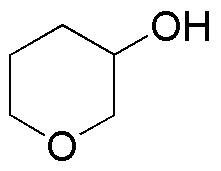Tetrahydropyran-3-ol is widely utilized in research focused on:
- Pharmaceutical Development: This compound serves as a versatile building block in the synthesis of various pharmaceuticals, particularly in the creation of complex molecules that can enhance drug efficacy.
- Flavor and Fragrance Industry: Its pleasant odor profile makes it a valuable ingredient in the formulation of flavors and fragrances, contributing to products like perfumes and food flavorings.
- Polymer Chemistry: Tetrahydropyran-3-ol can be used in the production of polymers, providing unique properties such as improved flexibility and durability in materials used for packaging and coatings.
- Organic Synthesis: This compound is a key intermediate in organic synthesis, allowing chemists to create a variety of chemical compounds efficiently, which is essential in research and industrial applications.
- Cosmetic Formulations: Its hydrophilic nature makes it suitable for use in cosmetic products, enhancing moisture retention and improving skin feel in lotions and creams.
General Information
Properties
Safety and Regulations
Applications
Tetrahydropyran-3-ol is widely utilized in research focused on:
- Pharmaceutical Development: This compound serves as a versatile building block in the synthesis of various pharmaceuticals, particularly in the creation of complex molecules that can enhance drug efficacy.
- Flavor and Fragrance Industry: Its pleasant odor profile makes it a valuable ingredient in the formulation of flavors and fragrances, contributing to products like perfumes and food flavorings.
- Polymer Chemistry: Tetrahydropyran-3-ol can be used in the production of polymers, providing unique properties such as improved flexibility and durability in materials used for packaging and coatings.
- Organic Synthesis: This compound is a key intermediate in organic synthesis, allowing chemists to create a variety of chemical compounds efficiently, which is essential in research and industrial applications.
- Cosmetic Formulations: Its hydrophilic nature makes it suitable for use in cosmetic products, enhancing moisture retention and improving skin feel in lotions and creams.
Documents
Safety Data Sheets (SDS)
The SDS provides comprehensive safety information on handling, storage, and disposal of the product.
Product Specification (PS)
The PS provides a comprehensive breakdown of the product’s properties, including chemical composition, physical state, purity, and storage requirements. It also details acceptable quality ranges and the product's intended applications.
Certificates of Analysis (COA)
Search for Certificates of Analysis (COA) by entering the products Lot Number. Lot and Batch Numbers can be found on a product’s label following the words ‘Lot’ or ‘Batch’.
*Catalog Number
*Lot Number
Certificates Of Origin (COO)
This COO confirms the country where the product was manufactured, and also details the materials and components used in it and whether it is derived from natural, synthetic, or other specific sources. This certificate may be required for customs, trade, and regulatory compliance.
*Catalog Number
*Lot Number
Safety Data Sheets (SDS)
The SDS provides comprehensive safety information on handling, storage, and disposal of the product.
DownloadProduct Specification (PS)
The PS provides a comprehensive breakdown of the product’s properties, including chemical composition, physical state, purity, and storage requirements. It also details acceptable quality ranges and the product's intended applications.
DownloadCertificates of Analysis (COA)
Search for Certificates of Analysis (COA) by entering the products Lot Number. Lot and Batch Numbers can be found on a product’s label following the words ‘Lot’ or ‘Batch’.
*Catalog Number
*Lot Number
Certificates Of Origin (COO)
This COO confirms the country where the product was manufactured, and also details the materials and components used in it and whether it is derived from natural, synthetic, or other specific sources. This certificate may be required for customs, trade, and regulatory compliance.


